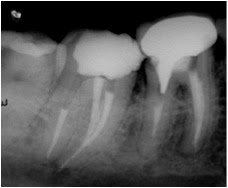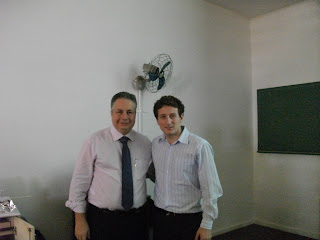segunda-feira, 28 de novembro de 2011
domingo, 27 de novembro de 2011
JOE nov 2011 - Apical Extrusion of Sodium Hypochlorite Using Different Root Canal Irrigation Systems
Apical Extrusion of Sodium Hypochlorite Using Different Root Canal Irrigation Systems
Ross P. Mitchell, BS, DMD, J. Craig Baumgartner, DDS, PhD, and Christine M. Sedgley, MDS, MDSc, PhD
Ross P. Mitchell, BS, DMD, J. Craig Baumgartner, DDS, PhD, and Christine M. Sedgley, MDS, MDSc, PhD
Introduction: Root canal irrigation carries a risk of extrusion of irrigant into the periapical tissues. The objective of this study was to compare different irrigation systems in matched pairs of teeth prepared to an apical size of 35.06 and 50.06 by measuring the frequency and extent of apical extrusion of sodium hypochlorite (NaOCl) into a simulated periapical environment. The null hypothesis was tested that there is no difference between systems.
Methods: Bilaterally matched pairs (n = 10) of single-canal extracted human anterior teeth were instrumented to an apical size of either 35.06 or 50.06. Teeth were embedded in a gel containing the pH-sensitive dye M-cresol purple that changes from yellow at pH 7.4 to purple at pH 9. Root canals were irrigated with 6% NaOCl (pH 11) by using EndoActivator (EA), EndoVac (EV), Rispi- Sonic/MicroMega 1500 (MM), passive ultrasonic irriga- tion (PUI), and syringe irrigation with a slot-tipped needle (SN), so that each tooth underwent all irrigation procedures in a randomized crossover design. Apical extrusion was evaluated by image analyses.
Results: The frequency of extrusion was less in teeth with apical preparation size 35.06 (36%) compared with 50.06 (60%) (P = .014) and was dependent on the irrigation system in 35.06 (P = .039) but not 50.06 groups. In the 35.06 group the frequency of extrusion was less for EV than for MM and SN (both P = .029). The extent of extrusion was less for MM compared with PUI (P = .024) and SN (P = .046) in the 35.06 group and greater for SN compared with all other systems in the 50.06 group (P < .05). The null hypothesis was rejected.
Conclusions: The frequency of apical extrusion of NaOCl was dependent on the type of root canal irrigation system and apical preparation size. The extent of extrusion depended on the irrigation system, with syringe and slotted-needle irrigation resulting in the greatest extent of extrusion.
Key Words
Apical extrusion, EndoActivator, EndoVac, Irrisafe, passive ultrasonic irrigation, root canal irrigation, sodium hypochlorite, Sonic Air MicroMega
(J Endod 2011;37:1677–1681)
sexta-feira, 25 de novembro de 2011
terça-feira, 22 de novembro de 2011
segunda-feira, 21 de novembro de 2011
domingo, 20 de novembro de 2011
HANDS-ON CIOSP 2012 : Movimento recíproco em Endodontia: introdução do sistema WaveOne / VAGAS LIMITADAS
A Equipe de Endodontia de Campinas representada pelo Prof. Carlos E. Silveira Bueno estará presente no 30o CIOSP no dia 28 de janeiro de 2012 (APCD CENTRAL) para mais uma atividade imperdível:
(Após hands-on os inscritos receberão o instrumento WaveOne)
Vagas Limitadas

Programa do Curso:
- O movimento recíproco e suas características.
- Quais a indicações e protocolo de utilização dos sistemas recíprocos.
- Hands-on clínico do sistema WaveOne.
JOE nov 2011 - Increased Apical Enlargement Contributes to Excessive Dentin Removal in Curved Root Canals: A Stepwise Microcomputed Tomography Study
Introduction: To determine whether increased apical enlargement would result in a complete preparation of curved canals and to progressively assess shaping quality using multiple microcomputed tomography (MCT) scans. Methods: Ninety root canals with a curva- ture of 25 to 50 were selected. Five MCT scans, 1 preoperative and 4 postoperative, were acquired from each canal. Canal preparation was performed up to size 50 using 3 techniques, nickel-titanium (NiTi) hand files, Mtwo (VDW, Munich, Germany), and ProTaper (Maillefer, Ballaigue, Switzerland), by experienced oper- ators in a dental mannequin so as to simulate the clinical conditions. At a level of 1 mm short of the working length, 2 parameters were evaluated in each of the 4 postoperative acquisitions: the percentage of the prepared outline and the amount of dentin removed (the prepared area). Results: Statistically, there was no significant difference between the 3 systems used regarding the prepared outline. The maximum prepared outline was achieved by the use of NiTi hand files (63%; confidence interval [CI], 54%–73%), whereas Mtwo and ProTaper amounted to 58% (CI, 50%–66%) and 60% (CI, 51%–70%), respectively. In contrast, the dentin area removed by ProTaper was significantly higher than that of Mtwo and NiTi hand files. Conclusions: Increased apical enlargement of curved canals did not result in a complete apical preparation, whereas it did lead to the unnecessary removal of dentin.
Key Words
Increased apical enlargement, microcomputed tomog- raphy scans, Mtwo, multiple analysis, ProTaper, root canal preparation, rotary systems, stepwise analysis
(J Endod 2011;37:1580–1584)
sexta-feira, 18 de novembro de 2011
quinta-feira, 17 de novembro de 2011
Sucesso TOTAL no III Congresso da SBENDO!!!
3o Congresso Internacional SBENDO 2011, sucesso total!!! 650 congressistas, 70 painéis apresentados, 19 expositores, Professores de reconhecimento Nacional e Internacional.
Parabéns a toda a comissão organizadora, ao presidente do congresso Prof. Carlos Bueno e ao presidente da SBENDO Prof. Manoel Machado.
Parabéns a toda a comissão organizadora, ao presidente do congresso Prof. Carlos Bueno e ao presidente da SBENDO Prof. Manoel Machado.
quarta-feira, 16 de novembro de 2011
sexta-feira, 11 de novembro de 2011
FOTO DE ALUNOS DA EEC NO CONGRESSO DA SBENDO
Observem a foto dos ex e atuais alunos da Equipe de Endodontia de Campinas- EEC
no Congresso da SBENDO. Precisa motivação maior?
Vocês são a força da nossa equipe. Obrigado!!!!
Vocês são a força da nossa equipe. Obrigado!!!!
quinta-feira, 10 de novembro de 2011
quarta-feira, 9 de novembro de 2011
terça-feira, 8 de novembro de 2011
Defesa da Dissertação de Mestrado em Endodontia da EEC- Aluna Luciana Louzada Ferreira
Curso de Mestrado em Endodontia / Equipe de Endodontia de Campinas / São Leopoldo Mandic
Aluna Luciana Louzada Ferreira
Título: Ausência de sensibilidade pulpar em caninos superiores submetidos ao tracionamento ortodôntico:Estudo clínico retrospectivo.
Banca: Carlos Eduardo da Silveira Bueno
Rodrigo Sanches Cunha
Luís Fernando de Mello Sant'Ana
segunda-feira, 7 de novembro de 2011
Prof. Marcos Húngaro nos cursos de Pós-graduação da Equipe de Endodontia de Campinas
Na última semana os cursos de Mestrado e Especialização em Endodontia da Equipe de Endodontia de Campinas tiveram o prazer de contar com a presença do Prof. Marco Húngaro.
domingo, 6 de novembro de 2011
Aula da Profª. Ericka Tavares Pinheiro no mestrado em Endodontia da EEC
Na última segunda feira , dia 31/10, a Profª. Ericka Tavares Pinheiro esteve no curso de mestrado em Endodontia da EEC para ministrar a aula: "Evolução dos métodos de estudo em microbiologia bucal: da cultura aos métodos moleculares."
Aula do Prof. Edwil Cantadori no curso de Especialização em Enododontia da EEC
O Prof. Edwil Cantadori Jr. esteve presente mais uma vz no curso de especialização em Endodontia da EEC para ministrar o tema "Atualidades da periodontia de interesse ao endodontista".
Prof. Carlos Bueno na 43a Semana Acadêmica de Odontologia da UFRGS
No dia 26 de outubro o Prof. Carlos Bueno esteve na Faculdade de Odontologia UFRGS para a 43a Semana Acadêmica de Odontologia representando a Equipe de Endodontia de Campinas. O Título da palestra foi "Fatores que modificaram a endodontia nos últimos anos"
Clínica da UFRGS
Prof. Marcus Só
quarta-feira, 2 de novembro de 2011
VIII Encontro de Endodontia da APCD Guarulhos
No dia 18 de outubro, os integrantes da Equipe de Endodontia de Campinas, Prof. Carlos Fontana e Prof. Augusto S. Kato estiveram no VIII Encontro de Endodontia da APCD Guarulhos a convite dos Professores Roberta Miguita, Luciano Scarparo e Kenner Miguita.
terça-feira, 1 de novembro de 2011
Assinar:
Comentários (Atom)











































